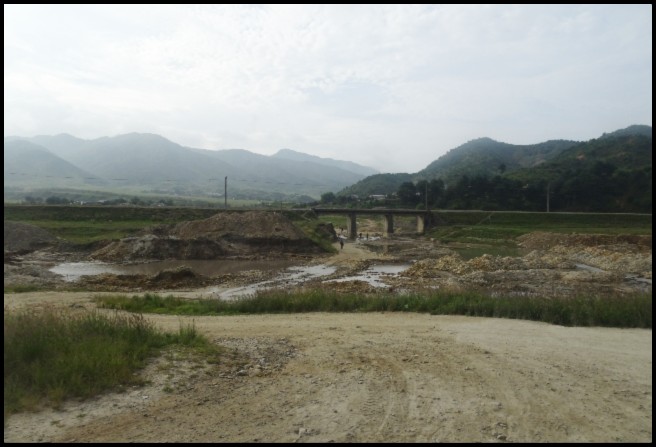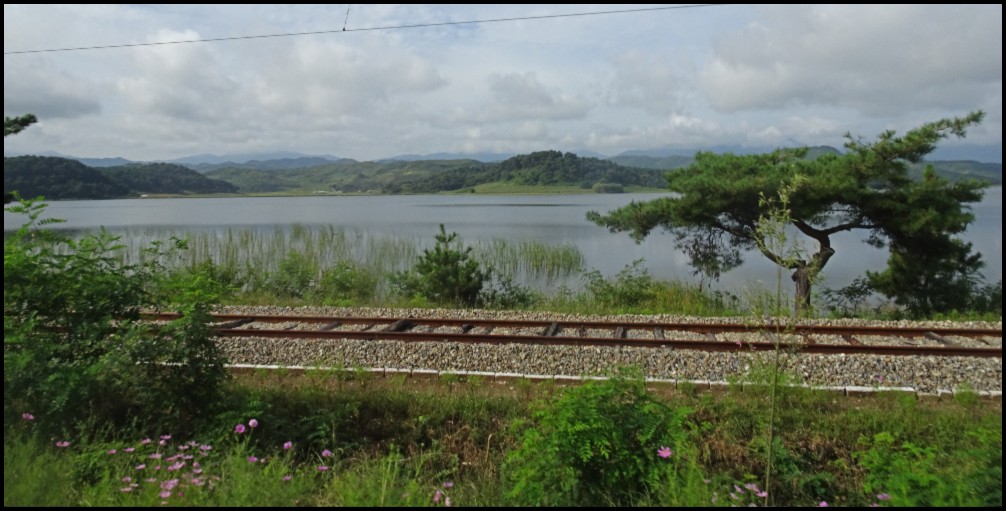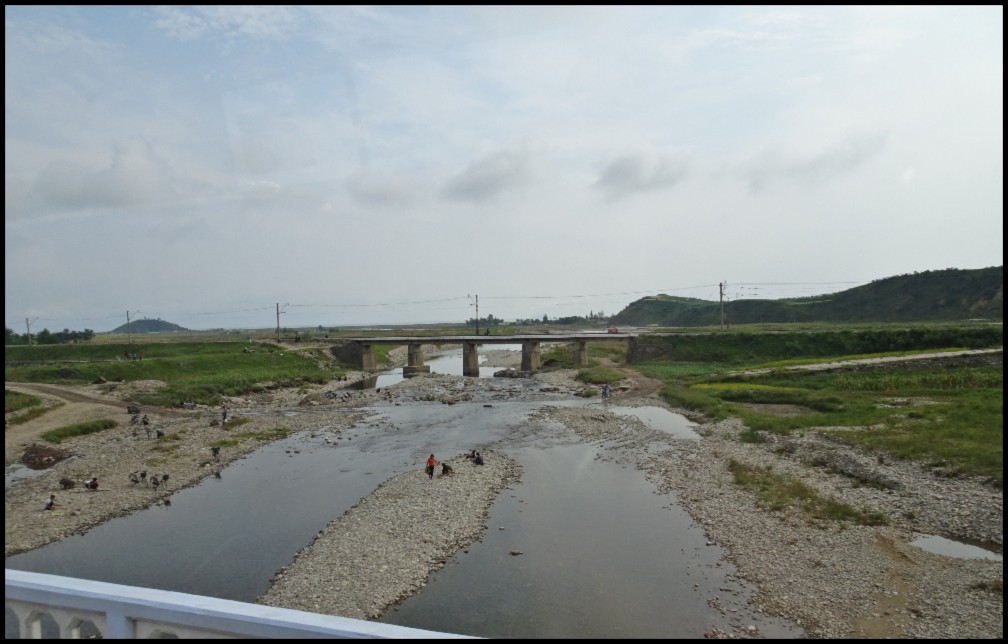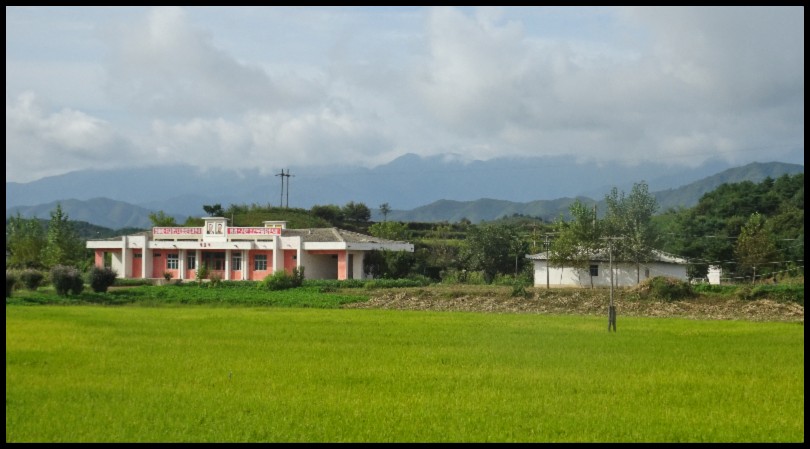Having left Wonsan our next stop was Mt Kumgang, three hours drive to the south, and to get there we drove along the (mainly) coastal National Highway 7 (AH6). For much of the way the highway runs in close proximity to the Kumgangsan Chongnyon railway line. Being a bit of a railway buff I enjoyed a bit of train station spotting en route to Mt Kumgang though sadly did not see any trains. In this post I share a few details on the line together with a few pictures of the stations I passed as well as a few other railway related snaps.
The Kumgangsan Chongnyon line runs down the east coast of North Korea from Anbyon south to Kamho, just north of the North-South Korean Border (DMZ), though the last couple of stations are rarely used making Kumgangsan Chongnyon station the effective southern terminus for the line. While a few train travel tours within North Korea are available to tourists I do not think that this line is currently included in any of them.

The original line which extended as far as Yangyang in what is now South Korea was built, between 1929 and 1937 by the Chosen Government Railway, the state owned railway company when Korea was under Japanese colonial rule. Japan had plans to extend the line to Pohang from which it would link to the major port city of Busan, on the south coast. This extension never eventuated as Japan lost Korea at the end of WWII, due to the heroic exploits of Kim Il-sung or the efforts of the Soviet Red Army – depending on which account appeals most to you.
Following Japan’s dislodgment from the peninsula the US and USSR agreed to split it in two with the northern part (pretty much today’s North Korea) coming under the control of the Soviet Union while the US took control of the southern part – today’s South Korea. As a result of this imposed partition the line was split with the section from Anbyon to Kamho becoming the Kumgangsan Chongnyon line within North Korea and the section from Jejin south becoming the Tonghae Pukpu line within South Korea. The section of line, across the border, between Kamho and Jejin was abandoned and left to decay.
I will come back to the post WWII history of the line but for now let’s have a look at some parts of the line I encountered on my bus trip from Wonsan to Mt Kumgang.
Anbyon, the northernmost station on Kumgangsan Chongnyon line is also a stop on the Kangwon line which links it to Wonsan, 16 kilometres to the north. Leaving Wonsan we followed the Kangwon line a few kilometres out of the city and into a rice growing area before veering of eastwards.


After a few kilometres we met up with the Kumgangsan Chongnyon line, a little before the second stop on the line, Sangum Chongnyon.




Moving on right along the coast, the next station we passed was Tongjongho


and then Myonggo Station

I noted above that this was a coastal line but my pictures may lead you to think otherwise. The reason for this is that the road almost exclusively runs between the train tracks and the coast meaning that pictures have to be taken pointing one’s camera inwards towards the hills to capture the line.
Prior to our arrival at the Lake Sijung Guesthouse for a short break both the road and the railway line travelled along a narrow strip of land seperating the lake for the sea, accordingly the water in my next picture is that of the inland Lake Sijung.

Suitably relaxed and refreshed we continued our journey south and shortly after the city of T’ongchon we crossed a river valley and so did the train line,

a short distance before it entered Tonghae Station.

Referring back to the river valley picture above – I noticed lots of people in and along the river-bed clearly foraging for stones. This is a common sight in North Korea and the stones could be being collected for a multitude of purposes though I am prepared to speculate that, given the proximity of the railway line in this instance, the stones are probably being collected to assist in the maintenance and beautification of the track. North Korean tracks, if somewhat dated and not always the best in terms of engineering, always look the part and are well presented.

By this stage the Mt Kumgang region and peaks were coming into view as depicted in my last picture below, taken on the outskirts of Changjon city just prior to a total photography ban being imposed. I will come back to that ban in another post but, to be honest, all the pictures in this review are technically in breach of photography rules anyway though, given that train trips are now available to tourists and the ban on photography from the Pyongyang to Sinuiju (for China) train has been lifted this broad ban is no longer enforced for the likes of the photos included here.

As promised earlier, to conclude this post I will briefly cover the post WWII history of the line and its prospects for the future.
The Korean War (1950-53) came and went (at least in terms of direct hostilities) and the line remained in two parts.
The North Korean part of the line, as far as Kumgangsan Chongnyon Station, was electrified in 1997, somewhat later than the country’s main electrification programme which to took place in the 1970s and 1980s – not because North Korea was away ahead in the race to be green but rather because it wanted to remove its heavy reliance on expensive imported oil (diesel). Rather than replace the locomotive fleet, which it would not have been able to afford to do even then, diesel engines were removed from many of its old (1950s and 1960s) Chinese locomotives and replaced with the necessary electrical gadgetry. These locomotives were re-badged as North Korean manufactured and many still operate today. Having previously imported locomotives from the China, the Soviet Union and other former Eastern Bloc countries locomotives are now manufactured in North Korea at the Kim Chong-t’ae Electric Locomotive Works in Pyongyang.
In 1998 North Korea opened up the Mt Kumgang region to South Korean and other foreign tourists and in 2002 the Mount Kumgang Tourist Region was separated from Kangwon Province and became a special administrative region specifically to cater to South Korean tourists, now permitted to enter the area by the South’s Government, under President Kim Dae-jung’s Sunshine Policy.
Initially South Korean tourists entered via sea or by road as significant work was required to re-establish rail links. In 2007 the abandoned track and infrastructure between Kamho and Jejin had been reconstructed and passenger trains began operating again, bringing hundreds of thousands of South Koreans north to the Mt Kumgang tourist region.
Following the shooting of a South Korean tourist who had wandered into a military area the Tourist Region was closed down in 2008 by the withdrawal of South Korean support – notwithstanding the millions of dollars that country had invested in the region. I will cover this joint venture further in another post. Suffice it to say here that the line between Kamho and Jeijin was closed a year after it re-opened and remains closed to this day.
While there is no cross border traffic on the line various discussions have been held between North and South Korea to re-open it as part of a trans-Korean freight line which would connect the South Korean railway network with Russia’s Trans-Siberian Railway. These discussions, together with similar discussions to re-open the line across the DMZ through Kaesong to allow the South Korean network to link with the Chinese network have been frustrated by the requirement of South Korea to have US approval – something which has been denied to them on a number of occasions.
In 2018 the US did give approval for a single South Korean train to pass through the DMZ and into North Korea. This was a track inspection train and under US mandated rules those aboard were forbidden to spend one cent in North Korea – everything down to drinking water had to be taken into the country and nothing could be left behind. Line inspection finished, the border crossing was resealed and no further progress has been made due to US lead sanctions against North Korea.
If you have managed to read this far you may be interested in a couple of other general railway posts I have written on North Korea.
Train Travel in North Korea – Trains for the People
Train Travel in North Korea – For No One and for the Leaders
My next North Korea (2018) – Mt Kumgang review– HERE
Return to the beginning of my North Korea (2018) – Mt Kumgang reviews – HERE


That is a place I would love to visit..only in South Korea..would be interested in seeing North Korea
LikeLiked by 1 person
It is well worth the effort. No where like it and it is hard to say that about any other country nowadays when they are all becoming increasingly similar.
LikeLike
I enjoyed reading your previous posts on North Korea – I’m quite sure I wouldn’t be brave enough to go there so am enjoying seeing your photos and hearing your perspective. I’d be really worried I was taking photos at the wrong time or something and would worry about the consequences!
LikeLiked by 1 person
It is a natural reaction to be nervous about going to NK, everyone is – based on what they see and hear outside NK . I have been twice now and first time I was very nervous about going but once there fears dissipate very quickly as the welcome accorded visitors is second to none in the world.. I had a different fear in the run up to my second visit and that was that Trump would do something to upset them while I was there. However when it came to time to go Trump and Kim were ‘in love’ .
You would have to do something horrendous to get in trouble (beyond being asked to delete offending photos) over photography. I have never heard of anyone being detained for photography (apart for journalists posing as tourists – a big no no.). Worst case they would just put you on the next plane out.
Prior to going to NK your tour company would provide you a list of rules… it runs to a dozen or so pages … but there are only two rules that will land you in serious trouble if breached and neither is easy to accidentally breach. Rule 1 – Promotion of any religion – this does not prevent talking to guides about it, which is fine to a degree .. but handing a guide (or anyone else a bible would be a serious offence. Rule 2 – Offending the leadership. …
Bottom line is that NK has nothing whatsoever to gain by detaining tourists and the %age of tourists that get in trouble in NK is infinitely smaller than get in trouble in any other country…. though admittedly penalties are high if you do fall foul of the government.
LikeLiked by 1 person
Fascinating to hear your perspective – thanks for taking the time to write back such a comprehensive reply! Apologies that I didn’t pick up this comment when you first posted it. I’m not sure what has happened as I seem to have missed a few and now going through and answering them. It will be interesting to see how things will play out under a Biden presidency hopefully a much calmer and more diplomatic foreign policy 🙂
LikeLike
Very interesting as always Albert 🙂 I think it must have been at a level crossing on this line, as we left Wonsan, that our bus was stopped for a train to pass through. We all reached for our cameras, naturally, and were immediately yelled at not to take any photos. Oddly, the ban on train photography had been omitted from our initial briefing, so this wasn’t mass rebellion on our part but simple ignorance! I am sure though that our particularly recalcitrant companion will have managed to sneak at least one photo before putting his camera away 😉 And no, that wasn’t me 😆 I’m surprised therefore that you were ‘permitted’ to take so many photos of the line and stations!
LikeLiked by 1 person
Thank you Sarah. There was no ban on pictures from the bus (until we got close to Mt Kumgang – only due to blatant misbehaviour of a couple of group members which I will refer to in my next post) so I took pictures from the bus in full sight of the guides 🙂 I will admit to a couple being a little naughty but the rest are fine. Unlike 2014 when all guides applied the same much simpler rules by 2018 different guides had different rules due, of course, to the rules having being significantly complicated/confused through relaxation. The railway network is one of the few things that Kim Jong-un had openly admitted that he cannot fix alone – hence his working with SK. Of course SK has a massive vested interest in running trains through NK so would, if allowed, pump vast sums into to system to achieve that end.
LikeLiked by 1 person
Interesting, thanks Albert 🙂 Yes, we found that different guides had different rules, most notably in Chongjin where it was much stricter – no photos from the bus at all anywhere. It was a our main guide, usually pretty relaxed, who vetoed the photos at the level crossing but I suspect that’s because there was a train in sight, whereas yours are only of the track and stations. Our UK guide also called out that we shouldn’t take photos there – it felt like quite a big deal
LikeLiked by 1 person
Yes, Chongjin was the most strict place we visited too. We had a ‘private company’ guide who ran the show.. ie not from KITC .. He was a real ‘jobsworth’ !!! Even our KITC senior guide (who took a back seat as he was not familiar with the area) said to me he felt he was over the top!!
LikeLiked by 1 person
Our KITC guide took a back seat too, for the same reason. She was more diplomatic than yours but I got the feeling she felt the same way
LikeLike
I can’t believe how prolific you’ve been. Haven’t read much, but saving it for when I go to Goulburn and when (if) I go to Nth KoreaGre
LikeLiked by 1 person
Good to hear from you again Joanne. I actually took a long break so also need to catch up on your posts too. I am trying to post on a regular basis – every second day – but am not sure how long I can keep that up as my ramblings seem to be getting longer and many of them , in particular on NK , take many many hours research. Hopefully you will get to both Goulburn and NK though the former should be a little easier for you 🙂
LikeLike